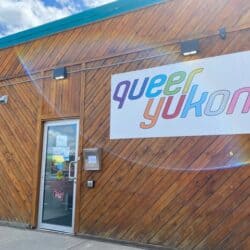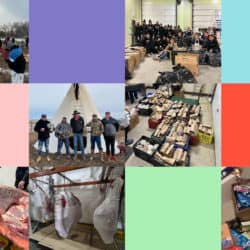Over the past year, hundreds of groups have sprung up to address community needs when governments and established institutions failed to do so. These volunteer-driven grassroots groups don’t have headquarters or boards of directors. Many don’t have websites or phone numbers. Mostly, they exist solely on social media and online forums.
Recalling the first lockdown in Winnipeg, Ryan Beardy vividly remembers how, at the same time that the streets emptied out and stores closed down, an influx of people began asking for food in the Mutual Aid Society (MAS) Facebook group. MAS, however, was ready.
When Winnipeg went into lockdown on April 1, the group had already been operating for two weeks. Community organizer and small-business owner Omar Kinnarath created it pre-emptively, knowing that when COVID-19 did start to spread in Manitoba, as it already had in Ontario, British Columbia, and Quebec, many would lose their incomes and access to social supports. Beardy quickly joined and became a moderator. In the beginning, people made posts asking for essential items like groceries, diapers, or masks, and others responded with what they could offer. Within a week, MAS had more than 1,300 members.
Beardy, who is Cree/Saulteaux from Lake St. Martin First Nation, was a long-time community organizer in Winnipeg and worried how the pandemic would affect a city that’s long faced social problems like homelessness and addiction.
“When the pandemic hit, I knew that it would affect marginalized communities way more than those who came from places of privilege,” Beardy says. “But at the same time, I knew the kind-hearted nature of human beings and that if we could connect those in places of privilege with those in places of disadvantage, we could see a balance.”
When the pandemic hit, I knew that it would affect marginalized communities way more than those who came from places of privilege.
Ryan Beardy
Beardy helps facilitate those connections. He links people who can help one another, organizing clothing drives and larger donation efforts, like the time he collected furniture for a young man’s first apartment when he was aging out of care with the Child and Family Services system.
As of July 2021, MAS has more than 9,300 members and is as active as ever. Food posts still make up the bulk of posts in MAS, but the group has also blossomed into an online forum where people can share information, from how to book vaccine appointments to alternatives to calling the police. “Black and Indigenous people have been using the group as a hub of information in times of distrust,” Beardy says.
MAS is just one of the hundreds of grassroots groups that have sprung up over the past year to address the specific needs of their communities when governments and established institutions failed to do so.
The Facebook group CareMongering-TO: TO Community Response to COVID19 – which, like MAS, is a place to share and organize community resources – has more than 25,300 members and inspired other “CareMongering” groups to launch across Canada. A network of community organizers and activists started the Black in BC Community Support Fund to give micro-grants to Black migrants, students, and gig workers experiencing financial hardship because of the pandemic. In Toronto, a small group of musicians and service workers who lost their jobs in the lockdown formed the Encampment Support Network and started bringing food, Gatorade, harm reduction supplies, and camping gear to people living in tent encampments. An out-of-work seamstress, a doctor, and a small crew of retirees teamed up to sew thousands of free masks in Pictou County, Nova Scotia. Medical students at the University of Toronto relaunched a program to call seniors living in insolation. And scores of “leave what you can, take what you need” community fridges have popped up in neighbourhoods across Canada.
These volunteer-driven grassroots groups don’t have centralized headquarters or boards of directors. Many don’t have official websites or phone numbers. Mostly, they exist solely on social media and online forums. What’s more, they’re not incorporated or structured as non-profits or registered as charities, which means it is difficult to track exactly how many of these groups exist across the country. Instead, they’re driven by passion and a wide range of volunteers – some who had experience working in the world of non-profits, but many with no formal experience at all.
All are united by a similar ethos: in a time of crisis, we must help one another. “In Indigenous culture, we say ‘all my relations.’ We’re all related. We’re all connected,” says Beardy. “When your family’s in need, what do you do? You help them. So for me, knowing that my neighbours are all this greater family, I wasn’t going to sit idly by while we all struggle.”
* * *
While “mutual aid” has become more of a mainstream concept in the pandemic, it’s not a new idea. Historically, mutual aid efforts have surfaced in times of crisis, like during the Great Depression, when Canadian families shared extra food and spare rooms with extended family and neighbours, and in times of scarcity, for example in rural North America during periods in the 18th and 19th centuries, when communities would collectively volunteer their labour and resources to build barns for neighbours.
The notion of mutual aid has been embedded within radical politics too. In the late 1960s, the Black Panther Party started a free breakfast program for children, created free bus routes to prisons for people to visit their incarcerated family members, and opened food pantries and health clinics. In fact, for generations Black people have been practising mutual aid through “money pools,” in which a group of people contribute to a fund knowing that they’ll each get a turn to dip into it. As Vicky Mochama writes in a piece called “Black Communities Have Known about Mutual Aid All Along” in The Walrus, “What enslaved people in Haiti and elsewhere knew is not too distant from the wisdom of Somali mothers and Grenadian aunties: if everyone gives, everyone gets.”
As history illustrates, the human impulse to assist and support one’s community has never been limited to formal charitable organizations. Mutual aid – or “caremongering,” another term that’s entered the popular lexicon in the past year – is a phenomenon that communities return to when the social safety net fails to catch the most vulnerable.
During the pandemic, when so many people were suffering from job insecurity, loneliness, health issues, and a lack of childcare, neighbours stepped up to support one another. And many were driven to volunteer their time and resources knowing they could have been in a similar situation if their circumstances were different.
Early in the crisis, as food banks across the country were slammed with increased demand and operating with reduced staff and hours, Jennifer Jetté began thinking about launching a community fridge in Calgary. It was a concept she first heard about years ago, while watching a documentary that showed how a community came together to make lunches for migrant workers in Dubai.
Jetté thought a similar idea could help neighbours who were struggling with food insecurity. She reached out to her friend Megan Kirk, who in turn connected with a couple of other friends, Sasha Lavoie and Alice Lam. Soon, the four of them began hatching their plan.
“The group that started the fridge – I wouldn’t say we’re low income anymore, but we each have definitely struggled,” says Jetté, who works as a stylist and in management for a salon group. “We were noticing that a lot of people in our periphery were stressed out about job security. We wanted to do something to bring a little less stress in the community.”
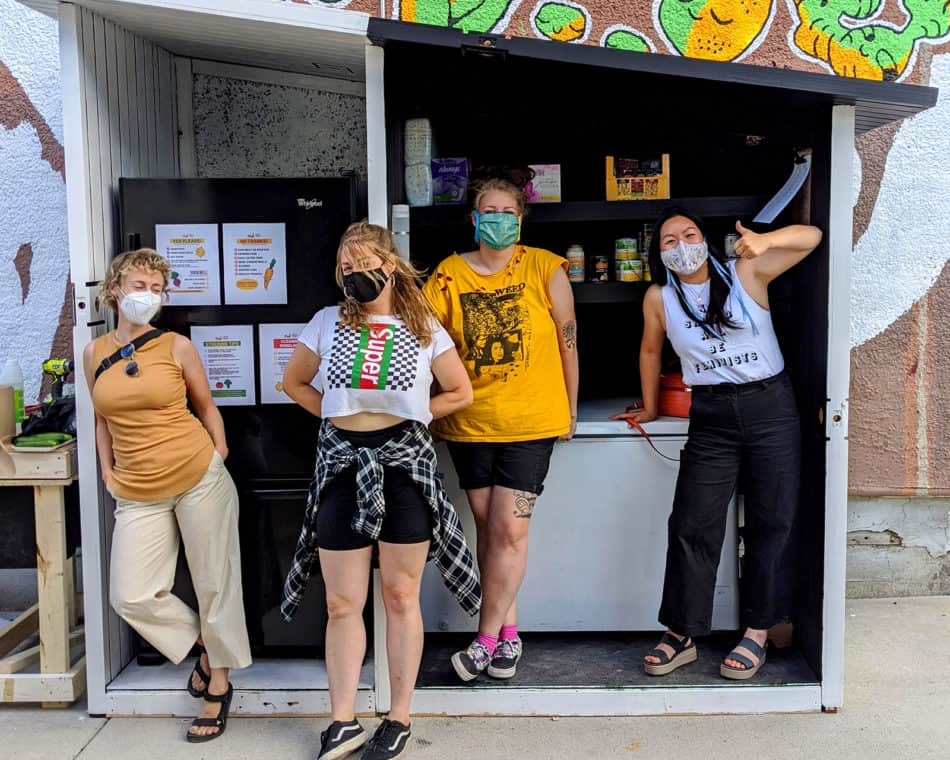
While community fridges began popping up guerilla-style in Toronto and New York City, Jetté knew that Calgary was a “red tape city,” so the group wanted to be as prepared as possible before launching their first fridge. They’d also heard about bylaw officers in Toronto ordering a fridge to be removed and wanted to avoid a similar scenario. They got food-handling certifications, figured out how to get insurance, and strategized on branding. They also connected with other community fridge organizers across North America and the UK to share expertise on what makes a good location and other insights, like how to winterize the fridges.
Last August, the Calgary Community Fridge (CCF) launched on Centre Street in the city’s Crescent Heights neighbourhood, located just north of downtown. The spot has a lot of pedestrian traffic but is also accessible by a number of bus routes. A cute, colourful mural of smiling fruits and vegetables surrounds the fridge/freezer and covered pantry. “If it looked too ‘fringey’ or too punk rock, people in the oil and gas industry here – who we need to support the fridge – would not take to it as well,” says Jetté. CCF enlisted an army of volunteers to clean the fridge twice a day, sign up for weekly grocery drop-offs, and collect donations at local businesses.
“We have really great food resources in our city, but they are still inaccessible to many people,” Jetté says. “To use the food bank, you need a government ID, and a lot of immigrants and houseless people don’t have that. We wanted to provide an alternative.”
We have really great food resources in our city, but they are still inaccessible to many people.
Jennifer Jetté
During the pandemic, the Calgary Food Bank required appointments, and didn’t allow drop-ins, which was another barrier for some vulnerable populations. With the fridge, Jetté says, the most popular time is from 11pm onward, when the food bank is closed.
CCF has around $27,000 banked from a GoFundMe campaign and also received a $1,000 grant from the city. But most of the food donations come from ordinary residents, who fill up the fridge and pantry whenever it starts to get bare. The concept of mutual aid is a core tenet for CCF. “We didn’t want to be city-sanctioned or [incorporated as a] non-profit,” says Jetté, who worked at a non-profit and saw firsthand how long it could take to get decisions approved. “We wanted to test the waters to see if mutual aid could function in our city. Is this something that we could pursue further?”
Jetté acknowledges that running on mutual aid can be challenging. Since CCF relies on community support, they needed to do a lot of promotion so they’re top of mind when people are thinking about where to donate. At peak times, Jetté and other members would put in upward of 20 hours per week. But it also has been encouraging for her and the other members to see how the neighbourhood came together.
* * *
In the spring of 2020, a small group of Edmonton activists created Treaty 6 Community Outreach (T6O) to support people in the city who were experiencing homelessness. Volunteers would fill their cars’ trunks with food, masks, hand sanitizer, and harm reduction supplies like Narcan and drive around the city, looking for people on the streets and in parks. At the time, the shelters were at capacity, and many of the usual places where people can find temporary respite, like malls and transit stations, were closed. Those conditions prompted T6O and Indigenous community organizers to open Camp Pekiwewin last July as a longer-term solution to the rising homelessness and opioid crisis in Edmonton.
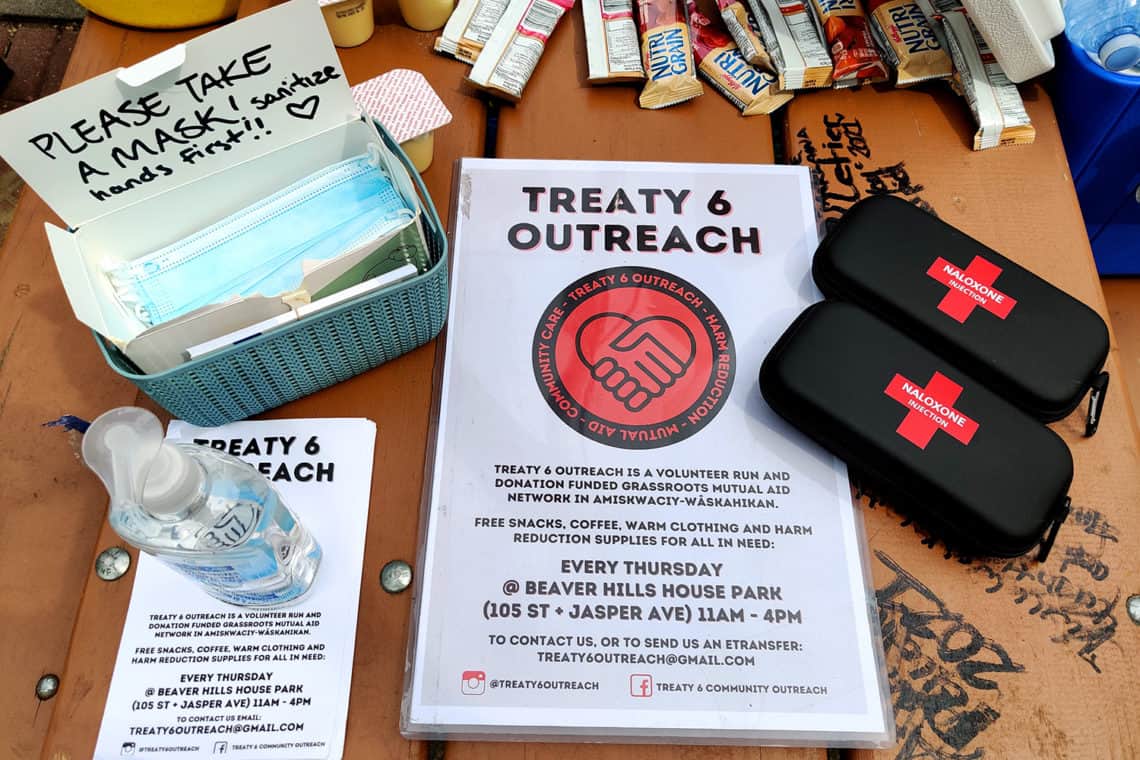
Camp Pekiwewin (Cree for “coming home”) started off with just a dozen tents and a white canvas teepee for Elders to lead prayers and traditional ceremonies. It eventually grew to more than 170 camps and contained an outdoor kitchen area with picnic benches and a medical-services area with 24/7 front-line healthcare workers. At its peak, around 400 people passed through the camp, accessing free food, traditional medicines, and community. But after operating for 100 days, the City of Edmonton shut it down in November.
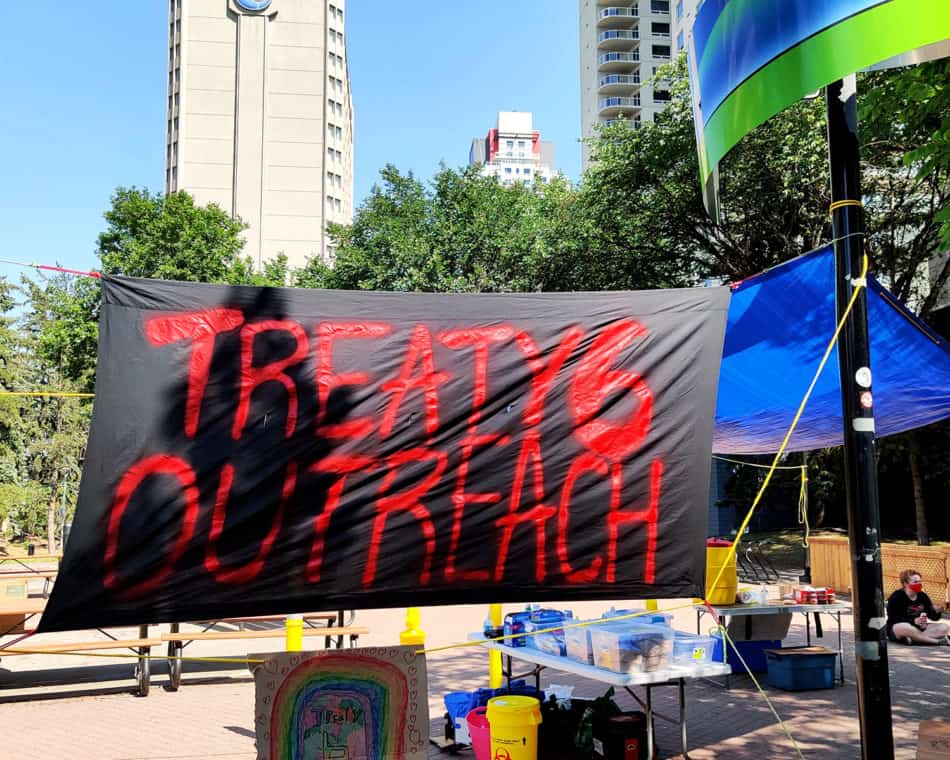
“When Pekiwewin got shut down, we were sort of lost and not sure what to do,” says Robert Lees-Miller, a member of T6O and a volunteer at Camp Pekiwewin. After a month of recuperating, T6O members started doing outreach again in the most highly trafficked parks in the city.
Like CCF, they’re not interested in establishing themselves as a non-profit or registered charity. “A lot of the people who are part of our collective do work for non-profits, either as volunteers or employees,” says Lees-Miller, who sits on the board of an environmental non-governmental organization. “One of the reasons why T6O is so appealing is because it offers something different from all of those spaces, not only for us, but for the people that we’re working for.”
He also knows that mutual aid will remain the heart of the group. “COVID has shaken everything up and got people thinking that maybe we can actually make a better world out of this, instead of returning to normal and going back to being stuck in that same rut. There’s been a big disruption to the status quo.”
That same spirit inspired Kofi Hope and Zahra Ebrahim to launch the Toronto-based Monumental last November, “a business working in service of the public good.” Monumental’s work runs the gamut from creative, studio-based projects and campaigns to equity-centred consultancy work with large institutions. From the beginning, Hope and Ebrahim knew that Monumental was going to have a different kind of business model.
“I wasn’t interested in doing another non-profit or charity because I’ve seen the good that comes from that, but I’ve also seen the restraints,” says Hope, who was the founder and executive director of the CEE (Careers Education Empowerment) Centre for Young Black Professionals, a charity. “In a non-profit, it’s just harder to be nimble because you’ve got your set mission, you’ve got your set direction from the board, you’ve got what your funders expect from you. With [Monumental], it’s our time, it’s our money. If we want to start an initiative, we can do it, we can experiment. There’s just more room for failure. If it doesn’t work we can try something else, whereas sometimes the cost for failure in the non-profit space is so high.”
I wasn’t interested in doing another non-profit or charity because I’ve seen the good that comes from that, but I’ve also seen the restraints.
Kofi Hope
“I challenge the orthodoxy that social change only happens in the social sector,” adds Ebrahim, who is an executive advisor to Deloitte on human-centred approaches to public sector innovation and is vice-chair of the Canadian Urban Institute. “It’s imperative that it must happen elsewhere as well. Everyone needs to think about this as an imperative.”
Although many of the grassroots groups interviewed for this story have no plans to incorporate as non-profits or register as charities, most are already collaborating with the social sector. Likewise, many larger institutions are seeing the benefits of working with “non-qualified donees” – like grassroots organizations and mutual aid groups – which are able to respond quickly to community needs.
“The pandemic helped organizations flow money in different ways,” says Ebrahim. “We saw mutual aid networks just raise money and give it to people. We saw non-profits, charities, and municipalities figure out how to get money to different groups doing the work.”
I challenge the orthodoxy that social change only happens in the social sector.
Zahra Ebrahim
While many groups have relied on crowdfunding and soliciting donations, Vaccine Hunters Canada operates under a different model: crowdsourcing and disseminating information. Bea Serdon remembers feeling very frustrated as she tried to book a vaccine appointment for her father in March. She heard about Vaccine Hunters Canada (VHC), a group that was releasing information about available vaccine appointments on Twitter and through Discord, a giant online chat forum. Serdon posted on Discord about her dad; within 30 minutes, VHC founder Andrew Young had located an appointment at North York General Hospital.
The 25-year-old York University political science student decided at that moment that she wanted to get involved. She started booking appointments for people she knew within her community who were at a greater risk of getting COVID and would also face more barriers finding appointments, like undocumented workers and Filipino nannies.
Since then, Serdon has directly booked approximately 200 appointments and has helped hundreds more find a slot. “I think one thing we can all agree is that the system is confusing,” she says. “I’m lucky and blessed to be in a situation where I can help bridge the gap for other people.”
In the earlier stages of the vaccination rollout, Serdon compared the task of booking a hard-to-find appointment to the adrenaline rush she gets when she scores K-pop (Korean popular music) concert tickets. But the reason she spent hours every day fielding queries is because she knew how her community had been affected by the virus. “I heard horror stories from friends about what they had to do and what they had to sacrifice at the height of COVID, so this was the least I could do to help. People would say, ‘Are you getting paid for it?’ And I’m like, ‘No, I’m just helping all I can.’”
VHC is completely volunteer-run, and although they have worked with public health units, local governments, and non-profits to share information about pop-up vaccine clinics, they don’t have any official affiliations and don’t accept donations. Instead, they draw on a large contingent of volunteers, like Serdon, who work during school lectures, lunch breaks, nights, and weekends.
Once Canada is fully vaccinated, VHC’s services will no longer be needed. That’s the reality for many grassroots groups that sprang up during the pandemic. One of those groups, CareMongering-TO, announced last month that it would be shutting down its 25,000-member Facebook group on July 15, noting that many of the social supports and services that had decreased during the pandemic have become more widely available again.
Yet some groups, tackling systemic issues like homelessness, poverty, and food insecurity, plan to outlast the pandemic since the conditions they’re addressing existed long before the crisis. For example, CCF is running Zoom info sessions and has created a guide about how to open a community fridge. T6O, in turn, recently expanded to three outreach days and has a working group to plan its long-term goals. “T6O started as a response to COVID, but it’s become obvious that the need will still be there after,” says Lees-Miller. “It wasn’t as though Edmonton had enough shelter space for everyone and was proactively housing people and the pandemic just threw a wrench into the system. It’s always been inadequate. The pandemic just pushed it into a severe crisis.”
Rachel Gray, former executive director of The Stop Community Food Centre and current operations director of the Global Alliance for the Future of Food, believes part of the reason grassroots organizing has become so prevalent is because individuals saw the fault lines in our systems firsthand. “People wanted to respond in an urgent situation with urgent action,” she says. “I think it is deeply reassuring to know that the caremongering instinct is there, that we really do want to figure out what it will take to help somebody.”
Gray, who has been a leader in the non-profit sector for more than 20 years, adds that witnessing those systemic failures may have also influenced people to donate directly to individuals or grassroots groups, bypassing traditional non-profits.
“People could make a donation to Second Harvest, The Stop, or Daily Bread, or they could just keep bringing a truckload of food to an encampment,” she observes. “I can tell you that for organizations like The Stop, it would cost us somewhere between $2 and $3 a meal per person. If somebody goes to the grocery and loads up their car and brings it to the encampment, they’re spending more money than The Stop did on that meal.”
People wanted to respond in an urgent situation with urgent action.
Rachel Gray
Gray doesn’t undervalue the work of grassroots organizing, but she wonders what will happen to these ad hoc networks in the future. She notes that prior to the pandemic a number of smaller organizations, to avoid competing for the same donors in an already tight funding environment, came together with larger like-minded non-profits.
“Now the question is, how are these organizations going to evolve? Are they going to formalize or are they going to stick around? I suspect many of them will disappear, [and] some of them may explore trying to figure out how to continue to sustain themselves and their work.”
In fact, there’s a precedent for grassroots groups born out of a crisis to evolve into social and political juggernauts. Meals on Wheels originated in the United Kingdom during the Second World War, when many people lost their homes and were no longer able to cook meals. The AIDS Coalition to Unleash Power (ACT UP) was formed in New York City by playwright Larry Kramer as a direct-action protest organization during the AIDS crisis. Black Lives Matter started in 2013 in response to the death of Trayvon Martin. It has since become one of the world’s largest social movements. And Idle No More formed in opposition to federal measures that severely weakened laws protecting the environment and the rights of Indigenous communities.
And although some grassroots leaders worry about burnout or donations drying up, they’re also buoyed by the progress they’ve made and how it’s inspired thousands of people to give back in ways they had never done before.
For Beardy, he hopes MAS will have a lasting presence in his community because he’s seen how much good it has brought. “It was the right movement needed at the right time,” he says. “It’s wonderful to be able to open up my phone and see a dozen families getting help, a child getting a laptop for school. For me, that’s sort of like candy for the soul.”
Online fundraising
On June 2, 2020, scarcely a week after the death of George Floyd, Canadians donated more than 30,000 times to GoFundMe campaigns, making it the most generous day in the crowdfunding site’s history. Over the course of the month, Canadians went on to donate more than $2 million to racial-justice-related GoFundMe campaigns, according to a GoFundMe spokesperson.
One of those fundraisers was Justice for Regis, which raised money for the family of Regis Korchinski-Paquet, the 29-year-old Black and Indigenous woman who died after police were called to her Toronto apartment. Started by her sister Renee, the campaign has raised more than $482,000 (as of July 2021), more than four times the original goal.
Over the past year, crowdfunding platforms like GoFundMe and Facebook Fundraisers have experienced a surge in new campaigns and donations. Similar to the explosion of mutual aid and grassroots groups, many were started by ordinary people not affiliated with any non-profit or charity. These include an ex-restaurant worker who launched the Toronto Restaurant Workers Relief Fund on GoFundMe, a social justice professor who raised more than $300,000 for the Black community in Nova Scotia, and a family friend who started a fundraiser for two Toronto siblings who lost their single mother to COVID-19. Likewise, “micro-giving” made up the majority of donations, with 70% of all donations under $50.
While GoFundMe has always been a popular platform to raise money for emergencies and medical procedures, in 2020 the fastest-growing donor categories were business, community, and volunteer. Between March 2020 and March 2021, more than 2,000 GoFundMe campaigns were launched to support Canadian businesses, with individual restaurants, bars, and other small businesses fundraising to cover rent and utilities during the lockdown.
Online fundraising has grown steadily in the past decade, prompting new legislation to create an equitable framework for campaigns mounted by non-registered groups. In 2011, the Uniform Law Conference of Canada, which develops legislation that provinces can adopt to create consistent regulations across jurisdictions, created the Uniform Informal Public Appeals Act (UIPAA).
First adopted by Saskatchewan, the laws were successfully put to the test when the Humboldt Broncos Memorial Fund Inc. was deciding how the $15.2 million raised on GoFundMe should be distributed, equitably and fairly, to victims’ families and survivors of the 2018 bus crash. In response to the expanding scope of online fundraising, the UIPAA has been further modernized. Renamed the Uniform Benevolent and Community Crowdfunding Act (UBCCA), the legislation now covers fundraising for humanitarian and public purposes – rather than those of a private nature – and gives courts the tools to address new issues in online fundraising, like what happens if the money raised greatly surpasses the original goal.
Yet while thousands of Canadians were making one-off donations to a bail fund or their favourite neighbourhood bar at risk of closing, charities were seeing their revenues drop. A February 2021 survey from Imagine Canada found that more than two-thirds of respondents were experiencing a decrease in donations. Although nearly half of charities reported a higher demand, they were also operating with fewer staff members and fewer volunteers. In its report, Imagine Canada concludes that “despite a slight improvement since the spring [of 2020], the financial situation of most organizations remains fragile.”
